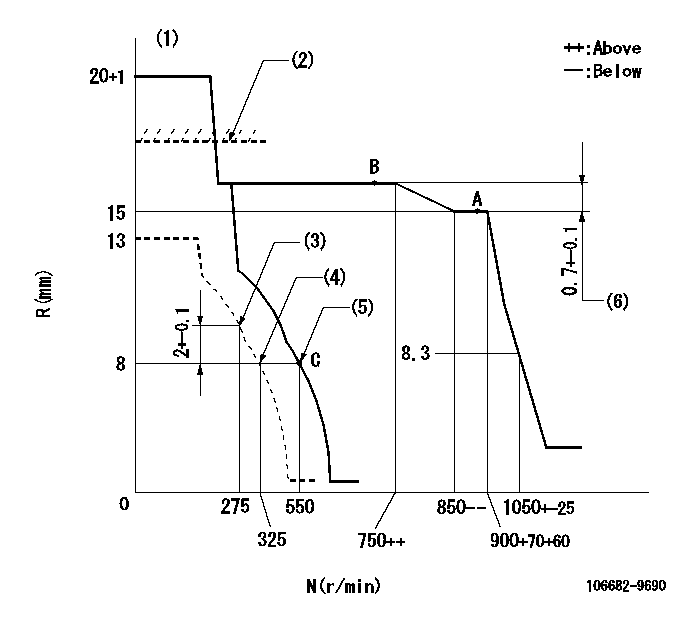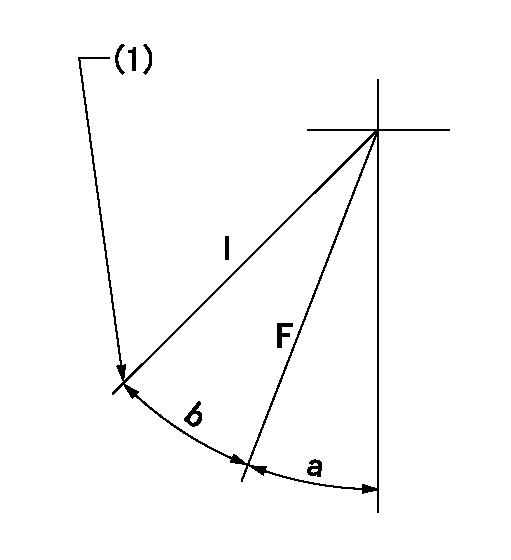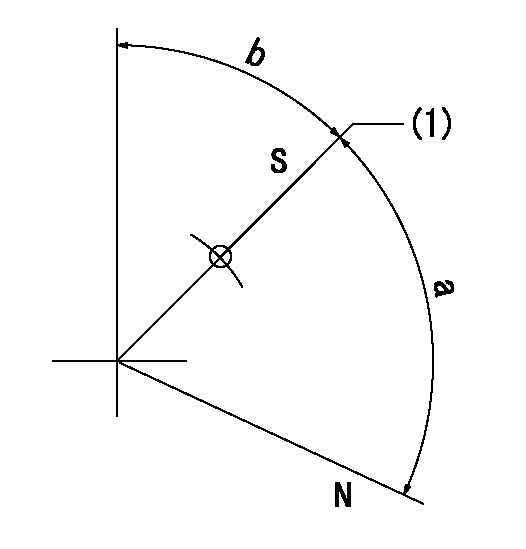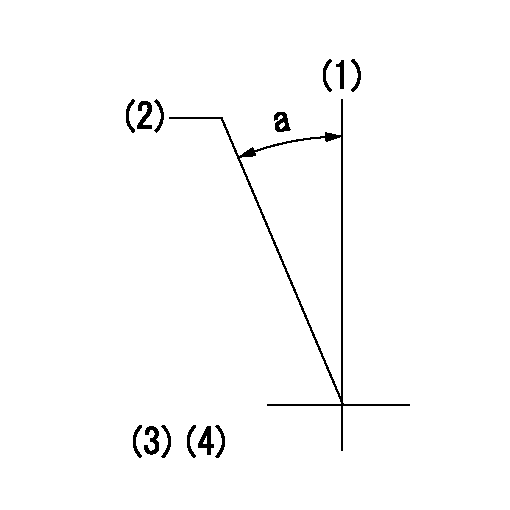Information injection-pump assembly
BOSCH
9 400 619 874
9400619874
ZEXEL
106682-9690
1066829690

Rating:
Service parts 106682-9690 INJECTION-PUMP ASSEMBLY:
1.
_
5.
AUTOM. ADVANCE MECHANIS
7.
COUPLING PLATE
8.
_
9.
_
11.
Nozzle and Holder
12.
Open Pre:MPa(Kqf/cm2)
24.5{250}
15.
NOZZLE SET
Include in #1:
106682-9690
as INJECTION-PUMP ASSEMBLY
Cross reference number
BOSCH
9 400 619 874
9400619874
ZEXEL
106682-9690
1066829690
Zexel num
Bosch num
Firm num
Name
Calibration Data:
Adjustment conditions
Test oil
1404 Test oil ISO4113 or {SAEJ967d}
1404 Test oil ISO4113 or {SAEJ967d}
Test oil temperature
degC
40
40
45
Nozzle and nozzle holder
105780-8130
Bosch type code
EFEP215A
Nozzle
105780-0050
Bosch type code
DN6TD119NP1T
Nozzle holder
105780-2090
Bosch type code
EFEP215
Opening pressure
MPa
17.2
Opening pressure
kgf/cm2
175
Injection pipe
Outer diameter - inner diameter - length (mm) mm 8-4-1000
Outer diameter - inner diameter - length (mm) mm 8-4-1000
Overflow valve
131425-1620
Overflow valve opening pressure
kPa
255
221
289
Overflow valve opening pressure
kgf/cm2
2.6
2.25
2.95
Tester oil delivery pressure
kPa
157
157
157
Tester oil delivery pressure
kgf/cm2
1.6
1.6
1.6
Direction of rotation (viewed from drive side)
Right R
Right R
Injection timing adjustment
Direction of rotation (viewed from drive side)
Right R
Right R
Injection order
1-5-3-6-
2-4
Pre-stroke
mm
3.5
3.45
3.55
Beginning of injection position
Drive side NO.1
Drive side NO.1
Difference between angles 1
Cal 1-5 deg. 60 59.5 60.5
Cal 1-5 deg. 60 59.5 60.5
Difference between angles 2
Cal 1-3 deg. 120 119.5 120.5
Cal 1-3 deg. 120 119.5 120.5
Difference between angles 3
Cal 1-6 deg. 180 179.5 180.5
Cal 1-6 deg. 180 179.5 180.5
Difference between angles 4
Cyl.1-2 deg. 240 239.5 240.5
Cyl.1-2 deg. 240 239.5 240.5
Difference between angles 5
Cal 1-4 deg. 300 299.5 300.5
Cal 1-4 deg. 300 299.5 300.5
Injection quantity adjustment
Adjusting point
A
Rack position
15
Pump speed
r/min
900
900
900
Average injection quantity
mm3/st.
355
352
358
Max. variation between cylinders
%
0
-3
3
Basic
*
Fixing the lever
*
Remarks
Standard point A's rack position same as row R
Standard point A's rack position same as row R
Injection quantity adjustment_02
Adjusting point
C
Rack position
8+-0.5
Pump speed
r/min
550
550
550
Average injection quantity
mm3/st.
42.5
41
44
Max. variation between cylinders
%
0
-15
15
Fixing the rack
*
Test data Ex:
Governor adjustment

N:Pump speed
R:Rack position (mm)
(1)Target notch: K
(2)Rack limit for 106684-4270
(3)Set the No 1 idle sub spring.
(4)Set the 2nd idle sub spring.
(5)Main spring setting
(6)Rack difference between N = N1 and N = N2
----------
K=15 N1=900r/min N2=700r/min
----------
----------
K=15 N1=900r/min N2=700r/min
----------
Speed control lever angle

F:Full speed
I:Idle
(1)Stopper bolt setting
----------
----------
a=20deg+-5deg b=16deg+-5deg
----------
----------
a=20deg+-5deg b=16deg+-5deg
Stop lever angle

N:Pump normal
S:Stop the pump.
(1)Pump speed aa and rack position bb (to be sealed at delivery)
----------
aa=0r/min bb=1-0.5mm
----------
a=(73deg) b=43.5deg+-5deg
----------
aa=0r/min bb=1-0.5mm
----------
a=(73deg) b=43.5deg+-5deg
Timing setting

(1)Pump vertical direction
(2)Coupling's key groove position at No 1 cylinder's beginning of injection
(3)-
(4)-
----------
----------
a=(30deg)
----------
----------
a=(30deg)
Information:
Air-to-air aftercooling systems are simple, reliable and easy to maintain and provide for one or more benefits.* Improved fuel consumption* Lower emissions* Increased powerOperation of ATAAC
Heated compressed air from the engine turbocharger is conveyed to an air-to-air aftercooler that is positioned in front of the engine radiator. The combined effect of the engine fan and ram air moves cooled air through the system to reduce the turbocharged air temperature before it enters the engine intake manifold.Lower intake air temperature allows more air to enter the cylinder, resulting in more complete fuel combustion and reduced exhaust emissions.Air-to-air aftercoolers can achieve charge air temperatures lower than water-to-air systems for additional efficiency.
To maintain an adequate water pump cavitation temperature for efficient water pump performance in an Air-to-Air aftercooled engine, Caterpillar recommends that the coolant mix contain a minimum of 30% Caterpillar Antifreeze, GM-6038M or equivalent.Only use a greater concentration (above 30%) of antifreeze as needed for anticipated outside temperatures.Ethylene glycol raises the boiling point of water.Do not exceed a coolant mixture of 60% ethylene glycol to water since a concentration above 60% ethylene glycol will reduce the engine's freeze protection and increase the possibility of deposit formation in the cooling system.Dowtherm 209 Full-Fill coolant cannot be substituted for ethylene glycol, due to its inability to raise the water pump cavitation temperature. Dowtherm 209 Full-Fill coolant lowers the boiling point of water.
Air Intake System
Never run the engine without an air cleaner installed or with a damaged air cleaner. Dirt will enter the engine and cause premature wear and damage to engine components.Service the air cleaner at regular intervals as determined by the operating environmental dust conditions. Check the air cleaner service indicator (if equipped) daily.As the air cleaner element becomes plugged, the difference of air pressure between the inlet side (dirty side) and the engine side (clean side) will increase. Service the air cleaners regularly or when the air cleaner service indicator diaphragm enters the red zone or the red piston locks in the visible position.Inspect the air intake hoses, elbows and gaskets for cracks or damage, replace as needed. Check for loose clamps, tighten as needed.Check the precleaner (if equipped) daily for accumulation of dust and debris.The Caterpillar air cleaner element may be cleaned up to six times, but must be replaced annually. The element when cleaned, should be thoroughly checked for rips and tears in the filter material and for gasket damage.Winter Fronts
Caterpillar discourages the use of winter fronts or other air flow restriction devices mounted in front of radiators with air-to-air aftercooled engines. Air flow restriction can cause higher exhaust temperatures, power loss, excessive fan usage, a reduction in fuel economy and possible engine damage.If a winter front must be used, then it should have a permanent circular or diamond-shaped opening directly in line with the fan hub and must have a minimum opening dimension of at least 120 sq. in. (770 sq. cm).A centered opening, versus a side or edge winter front opening is specified to provide sensing
Heated compressed air from the engine turbocharger is conveyed to an air-to-air aftercooler that is positioned in front of the engine radiator. The combined effect of the engine fan and ram air moves cooled air through the system to reduce the turbocharged air temperature before it enters the engine intake manifold.Lower intake air temperature allows more air to enter the cylinder, resulting in more complete fuel combustion and reduced exhaust emissions.Air-to-air aftercoolers can achieve charge air temperatures lower than water-to-air systems for additional efficiency.
To maintain an adequate water pump cavitation temperature for efficient water pump performance in an Air-to-Air aftercooled engine, Caterpillar recommends that the coolant mix contain a minimum of 30% Caterpillar Antifreeze, GM-6038M or equivalent.Only use a greater concentration (above 30%) of antifreeze as needed for anticipated outside temperatures.Ethylene glycol raises the boiling point of water.Do not exceed a coolant mixture of 60% ethylene glycol to water since a concentration above 60% ethylene glycol will reduce the engine's freeze protection and increase the possibility of deposit formation in the cooling system.Dowtherm 209 Full-Fill coolant cannot be substituted for ethylene glycol, due to its inability to raise the water pump cavitation temperature. Dowtherm 209 Full-Fill coolant lowers the boiling point of water.
Air Intake System
Never run the engine without an air cleaner installed or with a damaged air cleaner. Dirt will enter the engine and cause premature wear and damage to engine components.Service the air cleaner at regular intervals as determined by the operating environmental dust conditions. Check the air cleaner service indicator (if equipped) daily.As the air cleaner element becomes plugged, the difference of air pressure between the inlet side (dirty side) and the engine side (clean side) will increase. Service the air cleaners regularly or when the air cleaner service indicator diaphragm enters the red zone or the red piston locks in the visible position.Inspect the air intake hoses, elbows and gaskets for cracks or damage, replace as needed. Check for loose clamps, tighten as needed.Check the precleaner (if equipped) daily for accumulation of dust and debris.The Caterpillar air cleaner element may be cleaned up to six times, but must be replaced annually. The element when cleaned, should be thoroughly checked for rips and tears in the filter material and for gasket damage.Winter Fronts
Caterpillar discourages the use of winter fronts or other air flow restriction devices mounted in front of radiators with air-to-air aftercooled engines. Air flow restriction can cause higher exhaust temperatures, power loss, excessive fan usage, a reduction in fuel economy and possible engine damage.If a winter front must be used, then it should have a permanent circular or diamond-shaped opening directly in line with the fan hub and must have a minimum opening dimension of at least 120 sq. in. (770 sq. cm).A centered opening, versus a side or edge winter front opening is specified to provide sensing